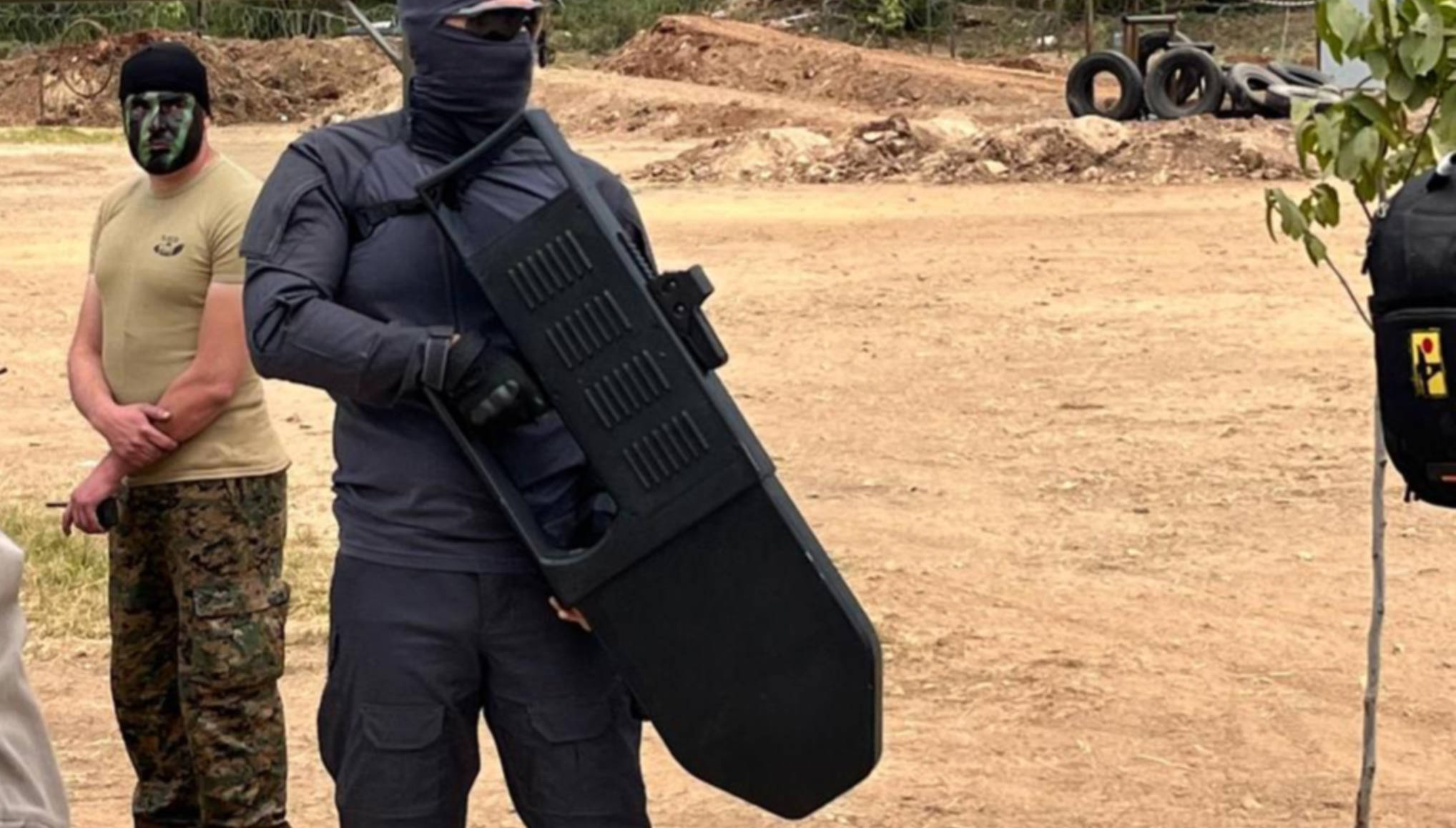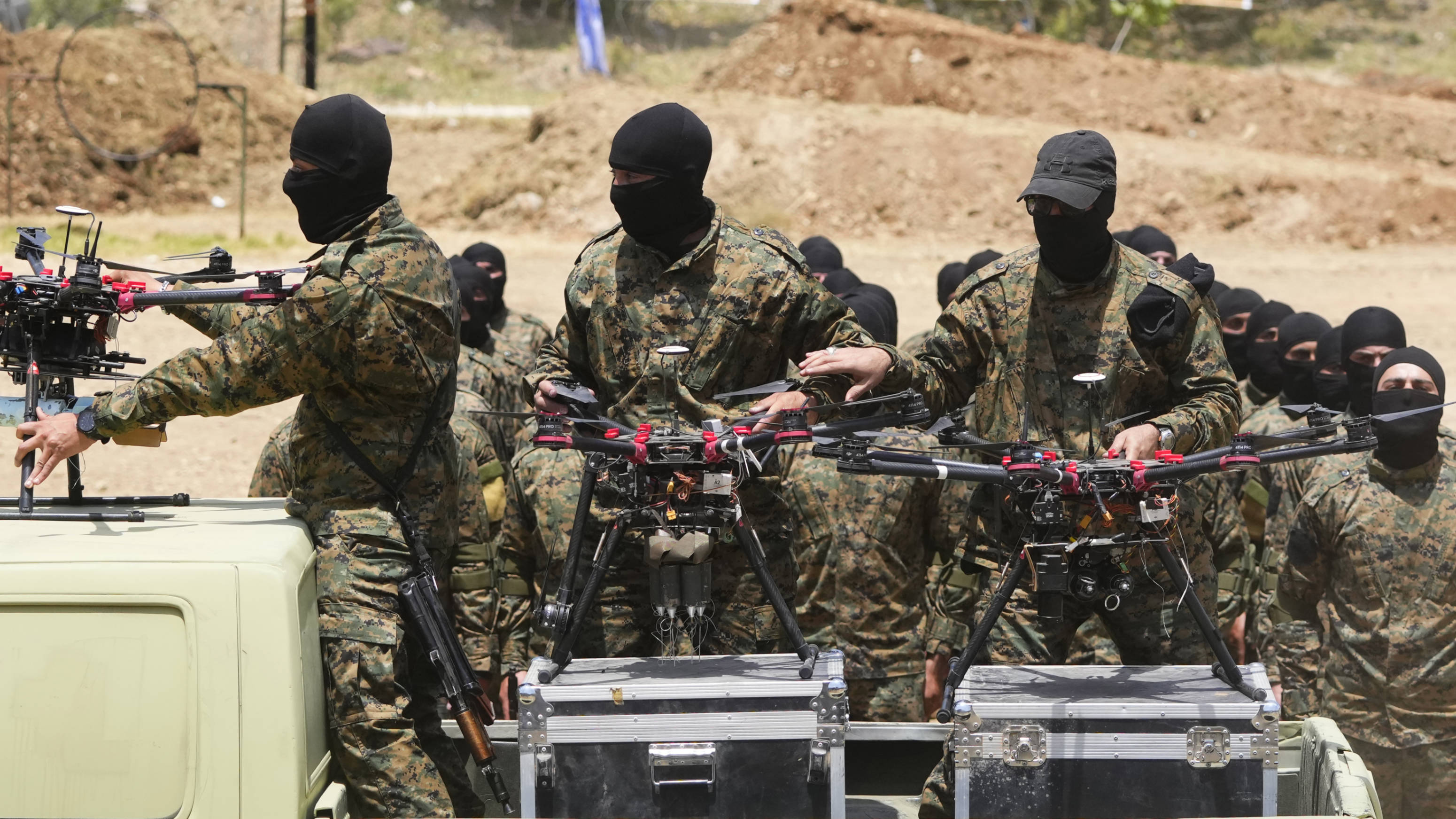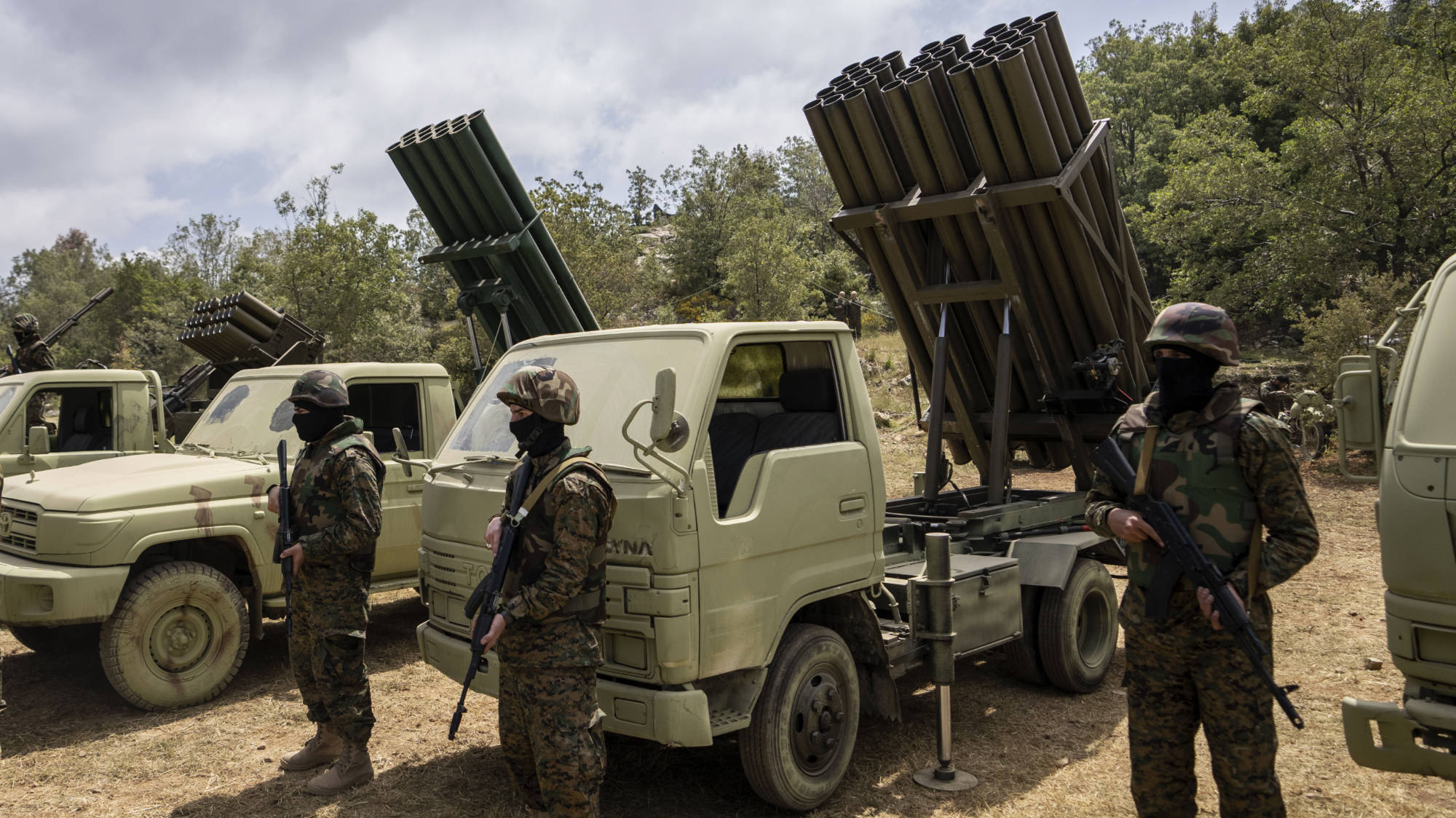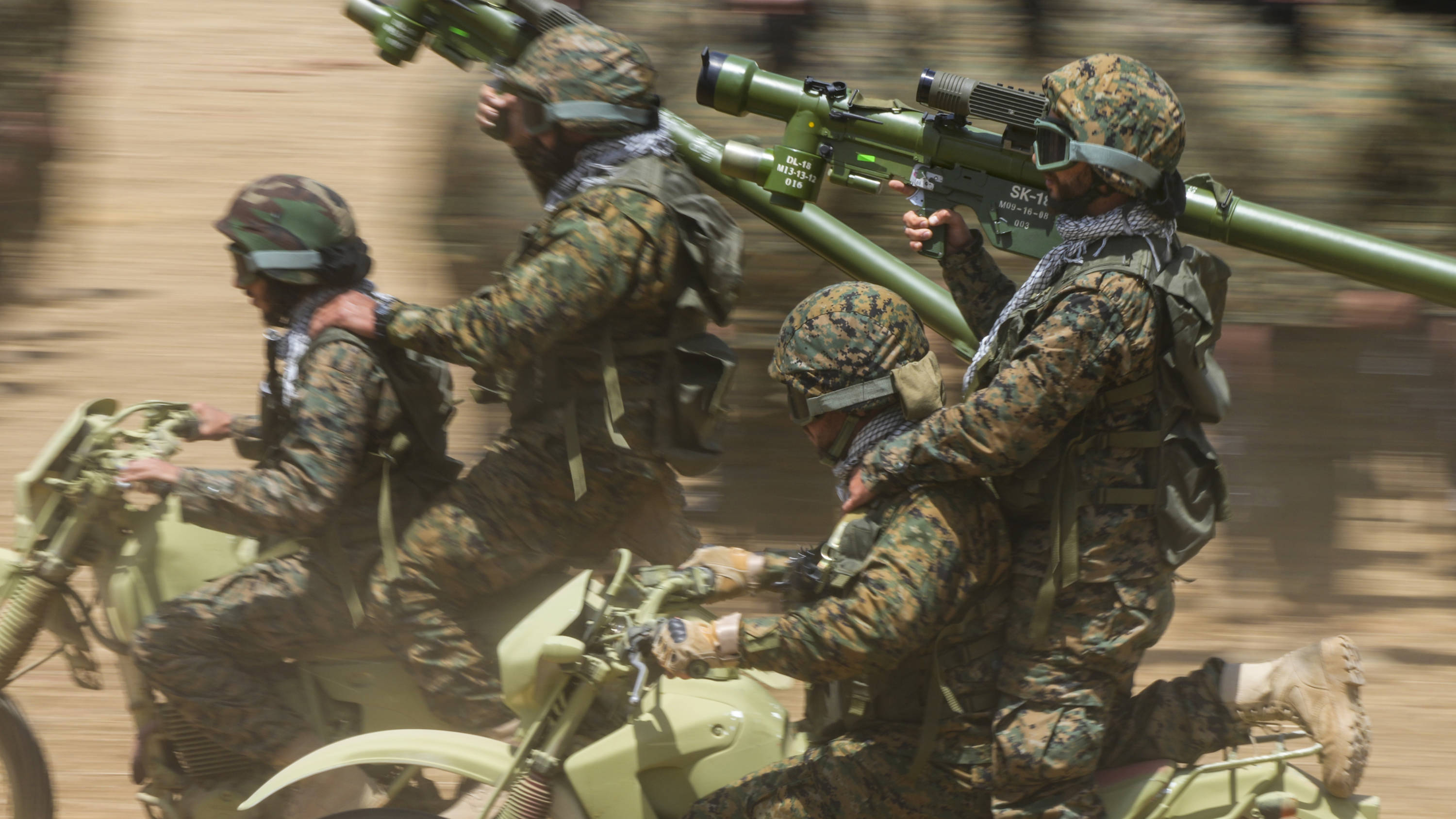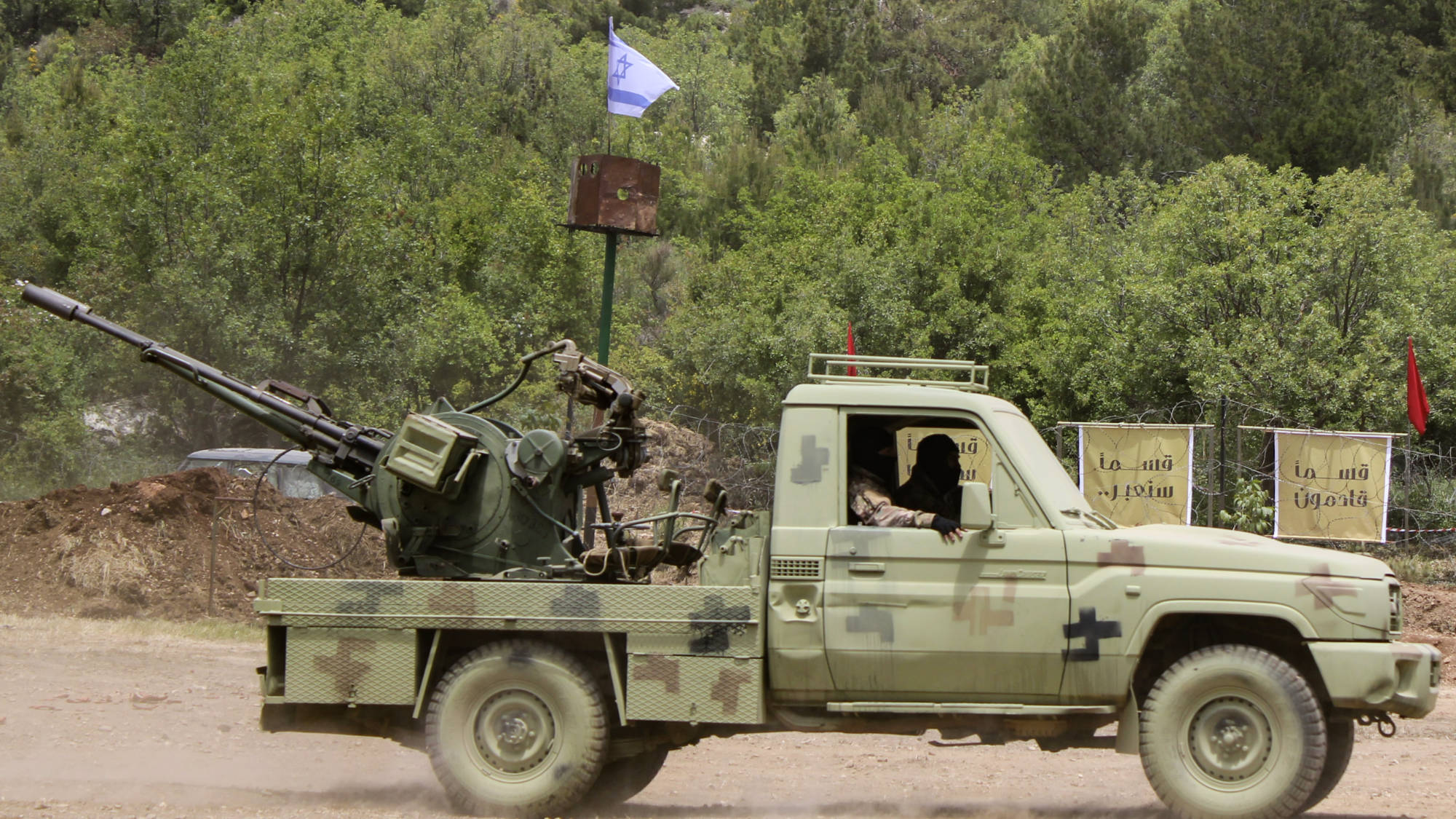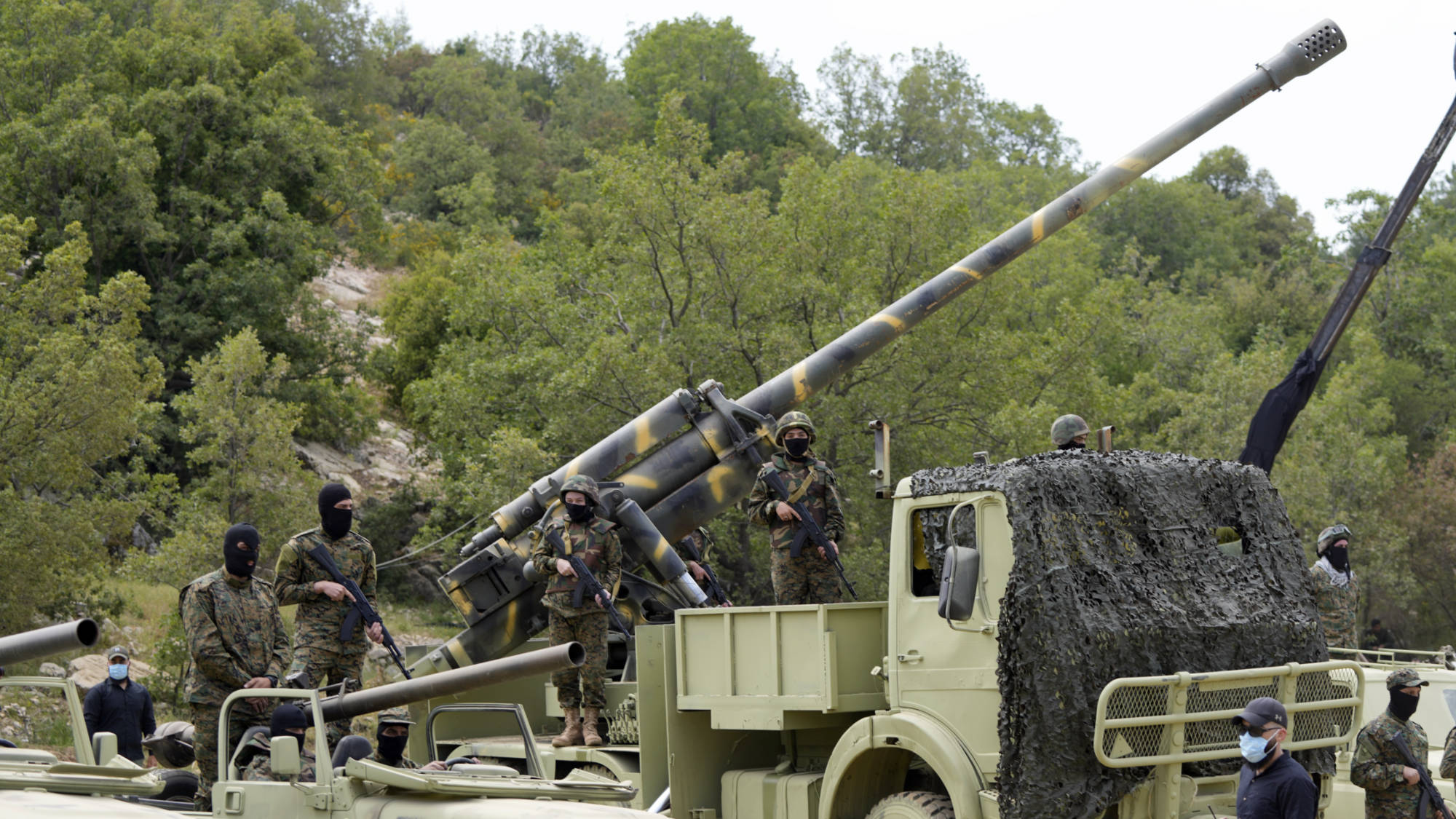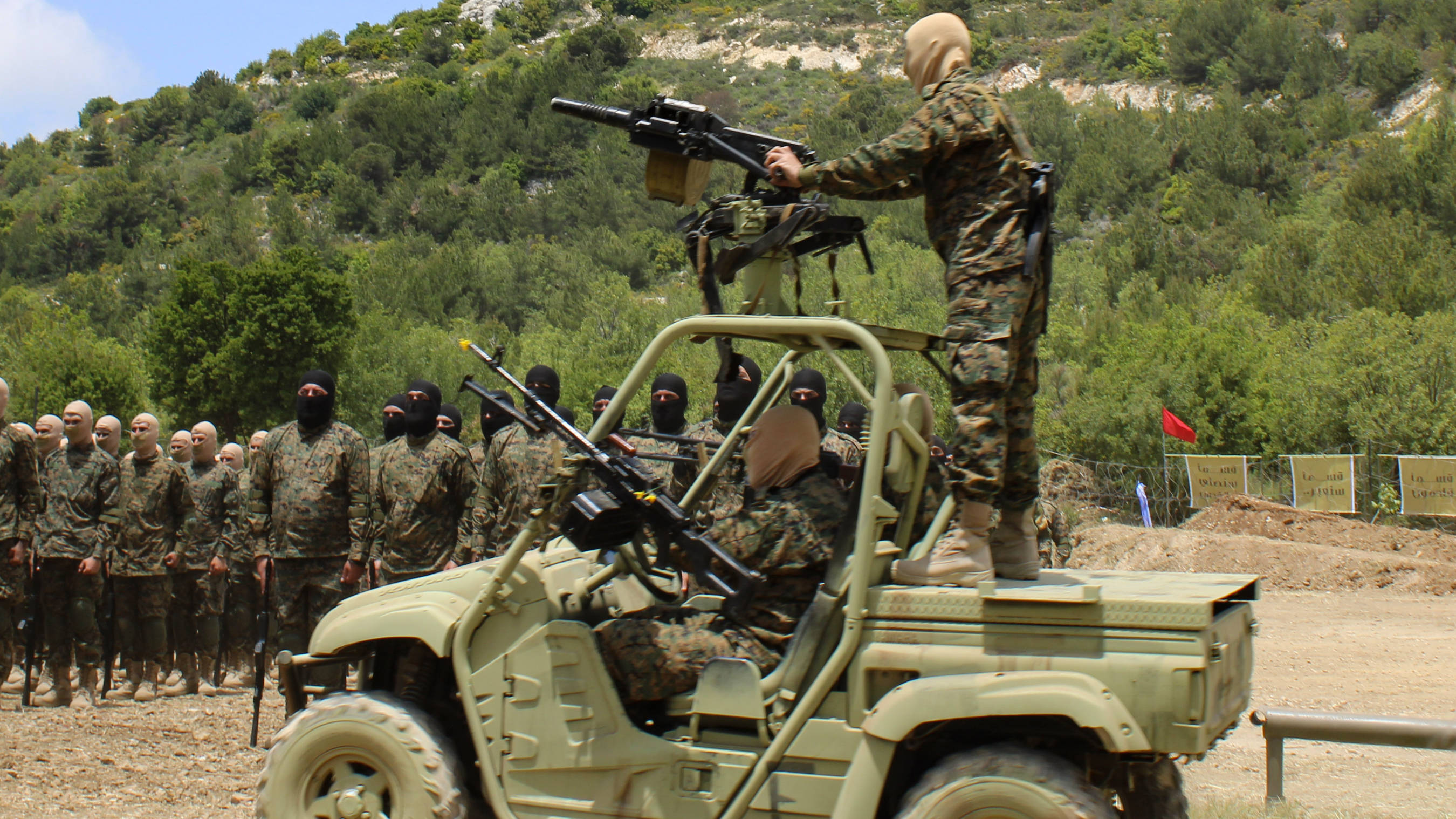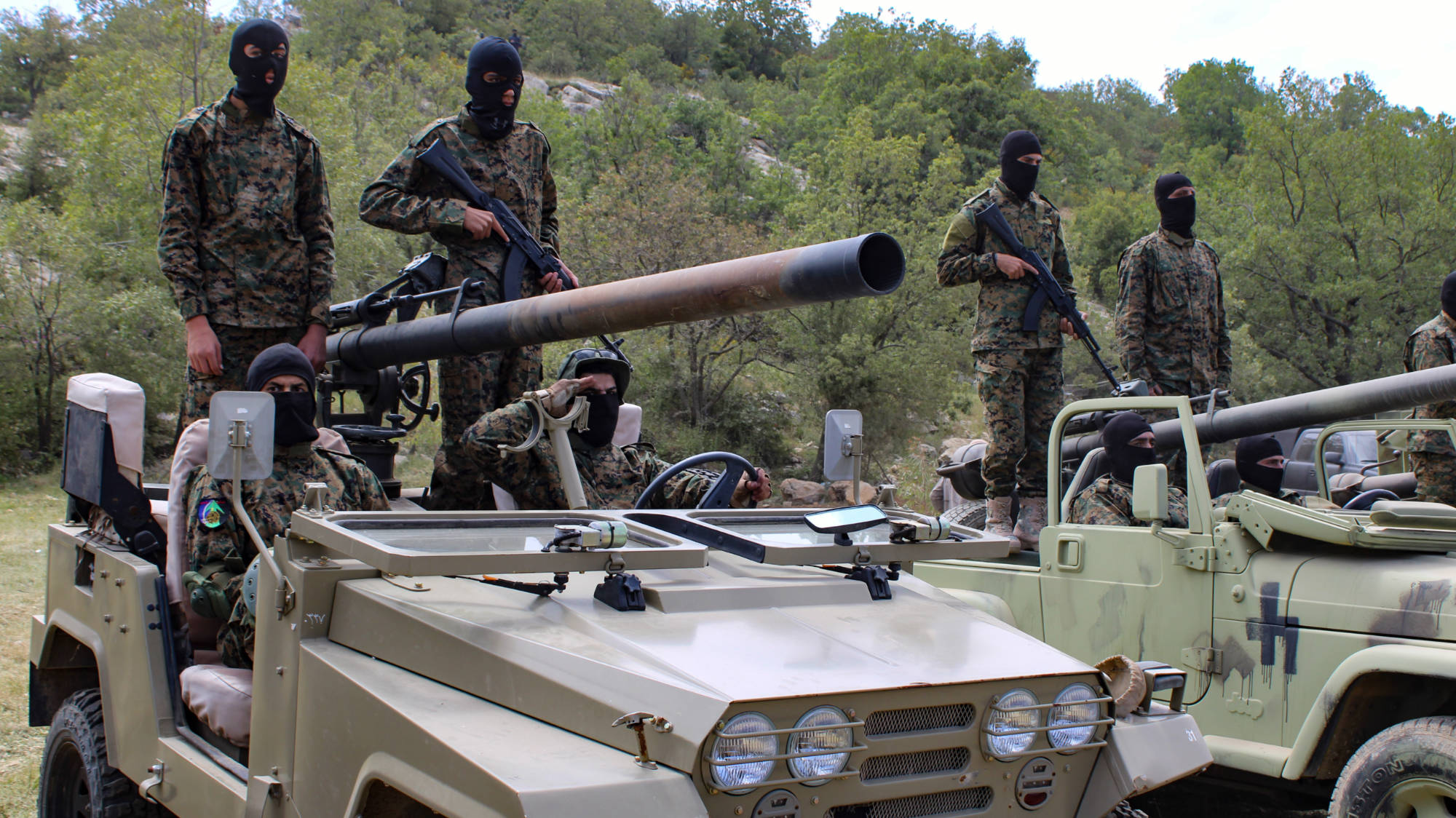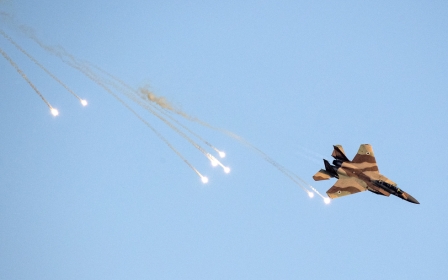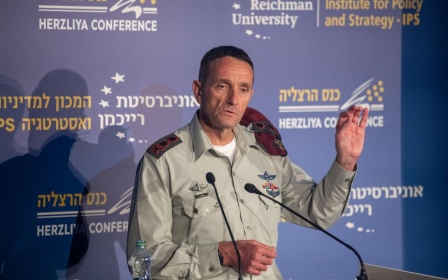Lebanon: Inside Hezbollah’s arsenal
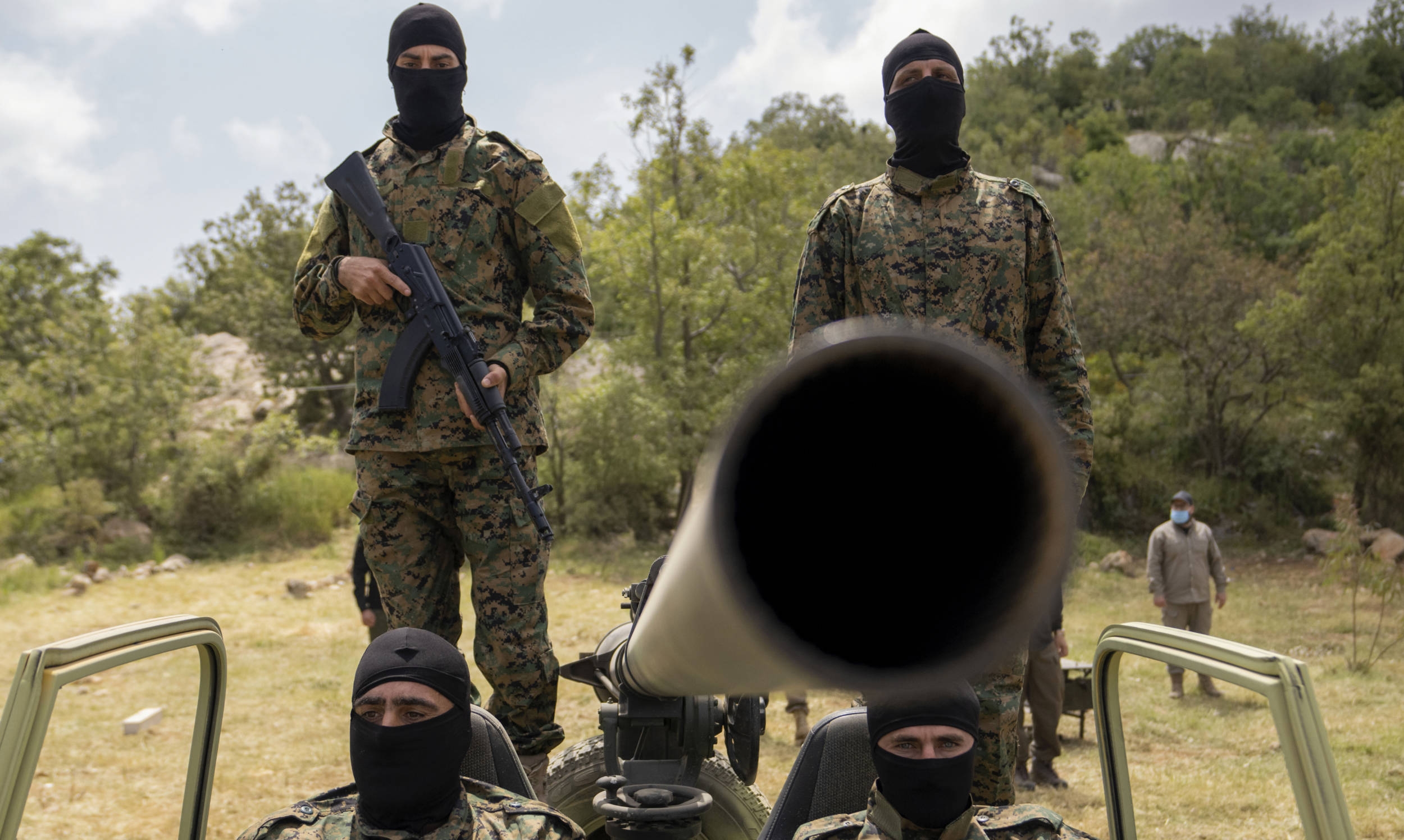
The Lebanese armed group Hezbollah put on a display of some of its previously secret arsenal and fighting power last week, extending a rare invitation to the media to visit one of its training sites in southern Lebanon.
Over the past two decades, the Iran-backed Shia group has risen to become the world’s most heavily armed non-state actor, according to a Center for Strategic and International Studies report.
During a two-hour-long military exercise in Aaramta village in the Jezzine district, the group showed off a broad range of small arms, light and heavy weapons. Notably, a significant number of anti-tank guided missiles, man-portable air defence systems, and armed and unarmed unmanned aerial vehicles were displayed, according to Armament Research Services, a specialist technical intelligence consultancy.
Senior Hezbollah official Hashem Safieddine said at the event that the display was only “modest”, with many of the group’s more destructive weapons kept out of sight.
Hezbollah was the only Lebanese faction allowed to keep its weapons after the end of the country’s 1975-1990 civil war, to fight Israel's occupation of South Lebanon, which ended with Israeli forces withdrawing in 2000.
New MEE newsletter: Jerusalem Dispatch
Sign up to get the latest insights and analysis on Israel-Palestine, alongside Turkey Unpacked and other MEE newsletters
Since 2006, when Hezbollah fought a 34-day war with Israel, its military arsenal has been “growing rapidly”, Souhayb Jawar, a Lebanese researcher of Islamist political movements, told Middle East Eye.
The group is now estimated to have a stockpile of 130,000 rockets and missiles, and some 20,000 active fighters and 20,000 reserves at its command. The group also has an extensive network that transports weapons to Syria and Lebanon, mostly via air and ground shipments through Iraq, Jawar said.
While its fighters and weapons largely serve as a deterrent against an Israeli military intervention in Lebanon, Hezbollah is also supportive of Iran’s regional agenda and has played a part in the conflicts in Syria, Iraq and Yemen.
Hezbollah “has become stronger than any military division in Lebanon”, Jawar said.
The group’s strength is driven by its religious beliefs, a stated objective of defending Lebanon against Israel, and immense financial support from Iran.
Anti-drones and drones
Hezbollah unveiled two hand-held anti-drone guns at last week’s show - the models unknown.
Anti-drone weapons have become increasingly critical as small drones have proliferated in modern warfare. The portable weapons can disrupt smaller drones that traditional air defence systems cannot detect, and disable them without causing physical damage, allowing for recoverable intelligence.
A wide range of anti-drone weapons have been developed by states and commercial enterprises, and some are even craft-produced and sold on the internet, according to Armament Research Services (ARES), which assisted MEE in identifying the weapons described in this article.
Agile and cost-effective, drones can provide great advantages to non-state actors, such as Hezbollah, which revealed last year that it had been manufacturing military drones in Lebanon.
On display in the recent media event were "heavy-lift" octocopters, the manufacturer unknown, which were equipped with improvised air-delivered munitions (IADM), ARES said.
Such drones are often used to hover over enemy positions and can drop the munitions with “remarkable accuracy”, ARES said.
Similar drones have been used in Ukraine, Syria and Iraq, where they have dropped munitions into open hatches on armoured fighting vehicles, for instance.
Alternatively, the drone could be equipped with optical equipment and used for intelligence and surveillance missions. The drone was likely a commercial, off-the-shelf item.
Iran has also ramped up its drone production and distributes them widely to its regional proxies. The second drone on display was likely a Rased or Rased-1, an Iranian copy of the Chinese Skywalker drone, ARES said.
The drone appears to be unarmed, according to ARES, indicating that it most likely serves a surveillance role, although the model could also be used for combat purposes.
Last year, during tense maritime border negotiations, the Israeli army intercepted three unarmed drones launched by Hezbollah, which were heading towards an offshore gas field in disputed Mediterranean waters.
Hezbollah’s rocket and missile arsenal consists mostly of small, man-portable, unguided artillery rockets, which, although they lack precision, are “effective weapons of terror” due to their “sheer number”, according to a 2018 report by the Center for Strategic and International Studies (CSIS).
Larger missiles missing
Some of Hezbollah’s larger, more destructive ballistic missiles were not displayed, said Shaan Shaikh, a CSIS fellow and co-author of the report.
He referenced the Iranian Fateh-110 and the Soviet Scud, which, with ranges of 250-300km and 300-550km respectively, are among the longest-range weapons in Hezbollah’s arsenal. The Scud could even reach Israeli targets from party-controlled territory in northern Lebanon, the report adds.
Hezbollah reportedly has kits that can turn regular, unguided rockets into precision-guided missiles, Shaikh told MEE. Precision-guided missiles (PGMs) can more precisely hit a target, minimising collateral damage and increasing fatalities among the enemy.
While Hezbollah leader Hassan Nasrallah and the Israeli military have spoken publicly about the Lebanon-based facilities where these missiles are made, there has not been enough operational use or recorded testing to confirm the group’s possession of these PGM kits, Shaikh said.
Safieddine threatened the use of PGMs at the show, saying that in the event of an Israeli aggression the missiles would “rain down” on the Jewish state.
The Russian 9M133 Kornet is an anti-tank guided missile (ATGM) commonly used against vehicles and sometimes structures.
The Kornet has a 4.6kg highly explosive warhead, capable of penetrating between 1,000 to 1,300mm armour. Syria is believed to have supplied Kornet ATGMs to Hezbollah in the early-to-mid 2000s, according to ARES.
The Iranian Toophan, another ATGM, is a reverse-engineered version of the American BGM-71 TOW.
A backbone of Iran’s ATGMs, it has a range of up to 3,750m and a highly explosive warhead of 3.6kg that can pierce armour approximately 550mm thick.
Iran also provided the Toophans to Hezbollah in the early 2000s and they were widely used against Israel’s Merkava tanks and other military vehicles in the 2006 Lebanon-Israel war. Hezbollah fighters have also used the Toophans against Islamic State operatives in Syria.
Various versions of craft-produced multiple-barrel rocket launchers (MBRLs) were displayed, fitted to civilian trucks, including 122mm and 107mm MBRLs. The 122mm can launch all 32 rockets in as little as 20 seconds, at a maximum range of 20-35km.
Although the rocket launcher was craft-made, the rockets were likely supplied by Iran. Hezbollah has used MBRLs to fire at targets in Israel on several occasions, ARES noted.
The RPG-29 Vampir (Russian for vampire) is a Soviet-era reusable rocket-propelled grenade launcher. It has a range of roughly 500m and can penetrate 1,500mm of armour.
Vampir were used against Israeli Merkava tanks in Lebanon, in some cases wounding or killing the crew members, according to ARES.
Although Iran is believed to be producing a copy of the RPG-29, Hezbollah likely acquired the weapon displayed through Syria, as its features more closely resemble the Soviet model, ARES noted.
Also shown in Hezbollah’s display were the Chinese-Iranian QW-18 series Manpads (man portable air defence systems), wielded by motorcycle fighters.
The QW-18s are portable air-defence missile systems, which can be used against low- and very low-altitude targets with a flight speed of over 300 metres per second.
The weapons are a low-cost protection against conventional airborne threats, such as anti-ship missiles, combat aircraft, helicopters and drones.
They were almost certainly supplied by Iran, which is believed to assemble the mostly Chinese-made QW-18 parts as the Misagh-2, according to ARES. The Manpads displayed in previous parades have often shown a mix of Iranian and Chinese components. In the most recent parade the weapons were fitted with Iranian thermal weapon sights.
The ZU-23-2 is a Soviet-developed twin-barrelled 23mm anti-aircraft autocannon, designed to engage low-flying targets.
The ground support weapon is a small and simple weapon that provides a high volume of fire.
The weapon has been used widely throughout the Middle East, particularly by Hezbollah and other non-state actors in the Syrian war.
Also on display were two models of artillery gun: the AZP S-60 autocannon and the Iranian 130mm M-46.
They are most commonly used against vehicles, structures and enemy forces in open terrain and have a range of about 61km and 27.2km respectively.
Hezbollah’s real advantage comes in its ground war tactics, as seen in an arms drill - where fighters jumped through flaming hoops, demonstrated their hand-to-hand knife combat skills, and fired Russian-made AK-103 and AK-104 rifles at targets adorned with the Israeli flag.
The shorter-barrelled AK-104 is sometimes associated with more elite formations of non-state armed groups and were most likely sourced in Syria, which has previously received a number of AK-103 and AK-104 rifles from Russia, according to ARES.
Fighters also held Russian Orsis T-5000 bolt-action precision rifles, which the group likely acquired via Syria or Iraq - the weapons have been used by the Syrian army as well as Iranian-affiliated Shia militiamen in Iraq, ARES said.
Also on display was an AGS-17 crew-served light grenade launcher, mounted atop two PKM-type general-purpose machine guns (most likely Chinese Type 80). The setup is used primarily as an infantry support vehicle or as a “shoot-and-scoot” attack platform.
The grenade launcher is capable of quickly firing multiple rounds of grenades up to a range of 800-1,700m.
A more powerful grenade launcher - the MK 19-pattern - was also shown. The MK-19 can launch its grenade over a maximum distance of 2,200m, although its effective range to a point target is about 1,500m. The 40mm grenades have a lethal radius of around five metres, depending on model.
The most common are high explosive, dual-purpose (HEDP). In addition, common types can penetrate about 50mm armour, according to ARES.
The MK-19, unlike the AGS-17, is not commonly known to be in Hezbollah’s arsenal. ARES suggested that it may have been diverted from Lebanese security forces, as the MK-19 displayed at the event did not have key features of the Iranian copy.
Meanwhile, the M40-type 106mm recoilless gun, likely Iranian copies of the American M40, play an anti-tank and anti-personnel role.
The M40s have long been popular with Iran and Iran-supplied groups, and are ubiquitous in the region, according to ARES.
Hezbollah’s arms drill was an apparent reminder to Israel, Iran and the Lebanese people of its military capacity and role.
The show was a “warning” against any military attempt the Israelis might resort to, said the Lebanese analyst Jawar. He added that the manoeuvre took an “offensive feature”, through the weapons displayed and the demonstration of an incursion into Israel.
Response to Iranian pressure
The military parade was also held amid increasing Iranian pressure for Hezbollah to be more assertive in the region, Jawar said. The day before the event, Iran’s ambassador to Lebanon, Mojtaba Amani, had warned of “empty economic promises” for countries that “retreat from their military capabilities”.
Hezbollah has begun to gradually withdraw forces from Syria, Jawar noted, which comes as Israel has ramped up aggression on Iranian facilities and proxies in the country.
The military exercise was also Hezbollah’s reminder to its Lebanese supporters of its stockpile of arms and refusal to engage in any sort of disarmament. The event could be seen as a show of determination ahead of the parliamentary elections, where campaigns by various political groups have focused on the issue of disarming Hezbollah.
A 22-year-old Lebanese told MEE, after the show, that the demonstration of weapons made his “feelings stronger” for Hezbollah.
“What I like about Hezbollah is that he’s not just fighting for himself… They are defending the Lebanese people,” he said.
This article is available in French on Middle East Eye French edition.
Middle East Eye delivers independent and unrivalled coverage and analysis of the Middle East, North Africa and beyond. To learn more about republishing this content and the associated fees, please fill out this form. More about MEE can be found here.


